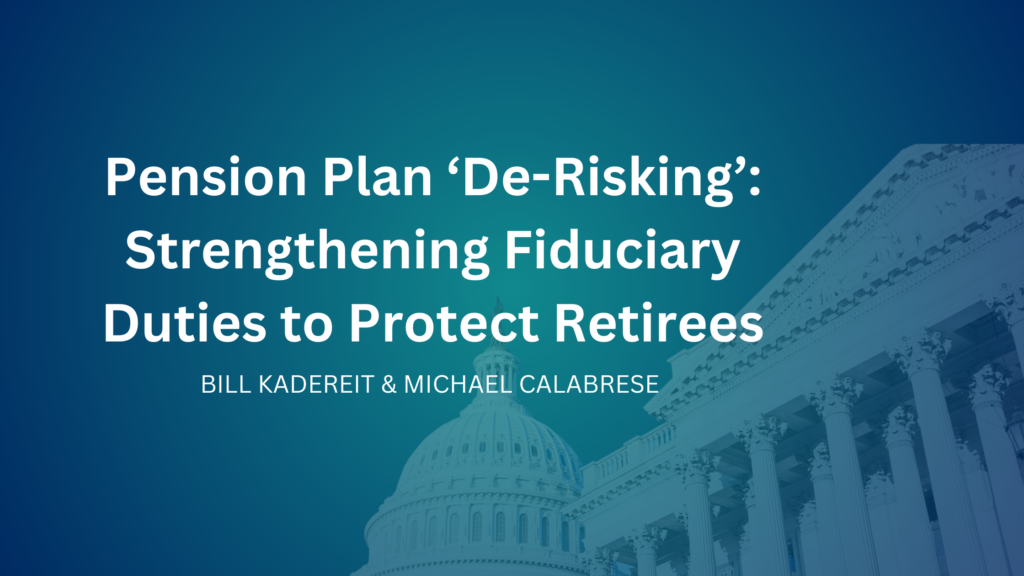
Michael Calabrese, NRLN Senior Policy Advisor, who researched and wrote the NRLN/AREF white paper on Pension Plan ‘De-Risking’: Strengthening Fiduciary Duties to Protect Retirees testified on July 18 before the Employee Retirement Income Security Act (ERISA) Advisory Council.
The 15-member council hears testimony, discusses retirement issues and presents recommendations to the Secretary of Labor regarding ERISA.
I testified before the council in 2013 and said that de-risking is a slippery slope that denies certain ERISA protections. From 2012 to 2013 General Motors terminated its management pension plan – pension benefits were annuitized – and 41,000 Verizon management plan participants’ benefits were also annuitized. No action was taken under ERISA.
Today, generally, insurer annuity payment obligations have been met, but numerous consulting firms are advising major U.S. corporate clients to de-risk plans rapidly. Insurance companies, sometimes backed by higher-risk investors, are entering the pension transfer annuity market. Over time, riskier annuity providers stand a greater chance of not meeting obligations. The time to act to put legal barriers in place is now.
Michael told the Council members that NRLN’s surveys of its members shows that threats to their income security from a pension plan termination, or from a de-risking transaction that transfers a sub-group of participants from their pension plan to an insurance company, is one of their greatest fears. These fears are rising in light of the rapidly growing volume of de-risking transactions, as well as major changes in the insurance and annuity industry.
He noted that one of ERISA’s core principles is its anti-cutback rule. No pension risk transfer should make a retiree or other participant worse off. Throughout workers’ lives they believed that the guaranteed monthly income they earned would be there for them as retirees and they had the additional value of a Pension Benefit Guaranty Corporation (PBGC) guarantee and other ERISA protections.
“A fiduciary standard based on ERISA Section 404(a) should more explicitly require single employer plan fiduciaries to negotiate annuity contract provisions that reasonably replicate ERISA protections in the event of the insolvency of the primary annuity provider,” Calabrese said. “Foremost among the protections that should be incorporated in a distributed annuity contract is full reinsurance of the monthly benefit itself.
He said what was earned and promised – a monthly pension income for life – is not adequately protected by state guaranty associations and remains very much at risk when a retiree is stripped of his or her PBGC insurance. When a retirement annuity is distributed, the benefits are often backed solely by state guaranty associations with limits as low as $100,000 per person/per lifetime.
“The only way to preserve the protections associated with vested pension benefits under ERISA is to clarify a fiduciary duty to incorporate them into the group annuity contract,” Calabrese pointed out. “Absent a fiduciary standard that enumerates the ERISA protections that should be incorporated, plan sponsors have little if any incentive to negotiate ERISA-like protections for group annuity contracts that cover retirees and others who will no longer be plan participants.”
He stated the NRLN’s position that only a group annuity contract that expressly requires independent, third-party reinsurance and prohibits the sale or transfer of the underlying assets to an entity that is not also a state-regulated and highly-rated insurance company that likewise maintains third-party reinsurance – can protect participants after they lose their ERISA protections.
Calabrese urged the Advisory Council to recommend that the Department of Labor not only advise Congress [of the need for legislation], but also move ahead to use its clear authority under Section 404(a) to update IB 95-1 to create a fiduciary safe harbor standard for distributed annuity contracts that incorporates explicit ERISA protections that include:
- The purchase of reinsurance from a third-party insurer that is independent of the annuity provider and financially capable.
- A prohibition on offering to convert or exchange individual annuity contracts for a lump sum or other change in the form of benefit.
- A provision prohibiting the re-sale or transfer of the annuity contracts to an entity that is not a state-licensed insurance company under the jurisdiction of U.S. courts – and that also satisfies the safest available annuity requirements of IB 95-1.
- A provision that prohibits the assignment or alienation of any payment or of the present value of the annuity.
- A requirement that the annuity provider send a short-form annual report to beneficiaries that confirms the reinsurance provider and the current rating and financial status of the annuity provider.
- A provision requiring that an annuity provider follow a state domestic relations order dividing the annuity in a manner that would satisfy ERISA § 206(d)(3)(B)(i).
- Prohibit the assessment of fees against the annuitant by the annuity provider.
- Finally, plan sponsors should affirm that the transfer of benefit liabilities to the insurer does not substantially impair the funded status of the plan after the de-risking transaction.
Since Calabrese only had 10 minutes for his oral testimony, he was allowed to submit written testimony to the ERISA Advisory Council.
Bill Kadereit, President
National Retiree Legislative Network
Read Michael's Testimony | White Paper
The entire NRLN white paper on pension plan de-risking is available on the NRLN website.
Read Testimony HereNRLN White Page - Derisking
 This website uses cookies to improve your experience while you navigate through the website. Out of these cookies, the cookies that are categorized as necessary are stored on your browser as they are essential for the working of basic functionalities of the website. We also use third-party cookies that help us analyze and understand how you use this website. These cookies will be stored in your browser only with your consent. You also have the option to opt-out of these cookies. But opting out of some of these cookies may have an effect on your browsing experience.
This website uses cookies to improve your experience while you navigate through the website. Out of these cookies, the cookies that are categorized as necessary are stored on your browser as they are essential for the working of basic functionalities of the website. We also use third-party cookies that help us analyze and understand how you use this website. These cookies will be stored in your browser only with your consent. You also have the option to opt-out of these cookies. But opting out of some of these cookies may have an effect on your browsing experience.